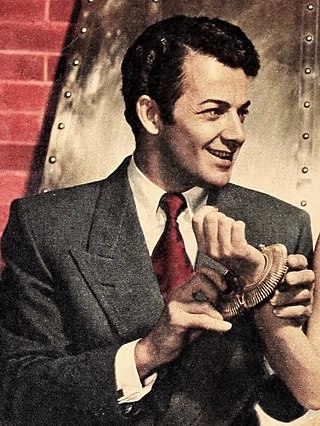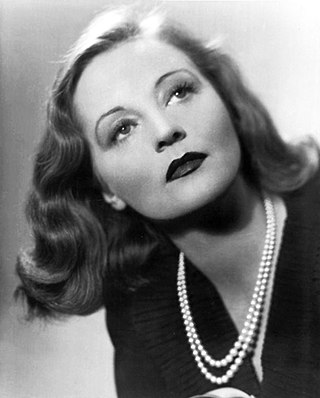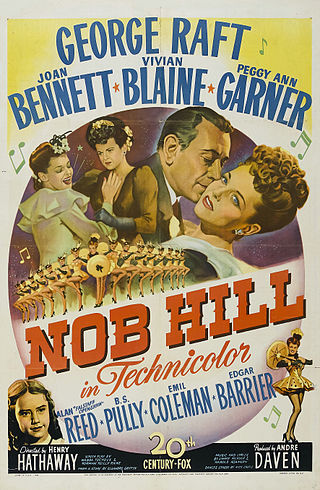
Ginger Rogers was an American actress, dancer and singer during the Golden Age of Hollywood. She won an Academy Award for Best Actress for her starring role in Kitty Foyle (1940), and performed during the 1930s in RKO's musical films with Fred Astaire. Her career continued on stage, radio and television throughout much of the 20th century.

Gilligan's Island is an American sitcom created and produced by Sherwood Schwartz. The show's ensemble cast features Bob Denver, Alan Hale Jr., Jim Backus, Natalie Schafer, Tina Louise, Russell Johnson and Dawn Wells. It aired for three seasons on the CBS network from September 26, 1964, to April 17, 1967. The series follows the comic adventures of seven castaways as they try to survive on an island where they are shipwrecked. Most episodes revolve around the dissimilar castaways' conflicts and their unsuccessful attempts to escape their plight, with Gilligan usually being responsible for the failures.

Cornel Wilde was a Hungarian-American actor and filmmaker.

Tallulah Brockman Bankhead was an American actress. Primarily an actress of the stage, Bankhead also appeared in several prominent films including an award-winning performance in Alfred Hitchcock's Lifeboat (1944). She also had a brief but successful career on radio and made appearances on television. In all, Bankhead amassed nearly 300 film, stage, television and radio roles during her career. She was inducted into the American Theater Hall of Fame in 1972 and the Alabama Women's Hall of Fame in 1981.

George Raft was an American film actor and dancer identified with portrayals of gangsters in crime melodramas of the 1930s and 1940s. A stylish leading man in dozens of movies, Raft is remembered for his gangster roles in Quick Millions (1931) with Spencer Tracy, Scarface (1932) with Paul Muni, Each Dawn I Die (1939) with James Cagney, Invisible Stripes (1939) with Humphrey Bogart, Billy Wilder's comedy Some Like It Hot (1959) with Marilyn Monroe and Jack Lemmon, and as a dancer in Bolero (1934) with Carole Lombard and a truck driver in They Drive by Night (1940) with Ann Sheridan, Ida Lupino and Bogart.

Peggy Ann Garner was an American child actress.

Billie Honor Whitelaw was an English actress. She worked in close collaboration with Irish playwright Samuel Beckett for 25 years and was regarded as one of the foremost interpreters of his works. She was also known for her portrayal of Mrs. Baylock, the demonic nanny in the 1976 horror film The Omen.
Black widow may refer to:

Mr. Hobbs Takes a Vacation is a 1962 American comedy film directed by Henry Koster and starring James Stewart and Maureen O'Hara. The film is based on the novel Mr. Hobbs' Vacation, by Edward Streeter and features a popular singer of the time, Fabian.

Marguerite Churchill was an American stage and film actress whose career lasted 30 years, from 1922 to 1952. She was John Wayne's first leading lady, in The Big Trail (1930).

Rescue from Gilligan's Island is a 1978 made-for-television comedy film that continues the adventures of the shipwrecked castaways from the 1964–67 sitcom Gilligan's Island, starring Bob Denver and Alan Hale, Jr., and featuring all the original cast except Tina Louise. The film first aired on NBC as a two-part special on October 14 and October 21, 1978. The film has the characters finally being rescued after 15 years on the island. The film was directed by Leslie H. Martinson.

Roxie Hart is a 1942 American comedy film directed by William A. Wellman, and starring Ginger Rogers, Adolphe Menjou and George Montgomery. A film adaptation of a 1926 play Chicago by Maurine Dallas Watkins, a journalist who found inspiration in two real-life Chicago trials she had covered for the press. The play had been adapted once prior, in a 1927 silent film. In 1975, a hit stage musical premiered, and was once more adapted as the Oscar-winning 2002 musical film.

Nob Hill is a 1945 Technicolor film about a Barbary Coast, San Francisco, United States saloon keeper, starring George Raft and Joan Bennett. Part musical and part drama, the movie was directed by Henry Hathaway. It remains one of Raft's lesser known movies even though it was a big success, in part because it was a musical.

We're Not Married! is a 1952 American anthology romantic comedy film directed by Edmund Goulding. It was released by 20th Century Fox.

Mary Eugenia Rawls was an American actress.

The Rebels is a historical novel written by John Jakes, originally published in 1975, the second in a series known as The Kent Family Chronicles or the American Bicentennial Series. The novel mixes fictional characters with historical events and figures, to narrate the story of the nascent United States of America during the time of the American Revolution. While the novel continues the story of Philip Kent, started in The Bastard, a large portion focuses on Judson Fletcher, a newly introduced character, as a different rebel. In 1979, the novel was made into a television film by Operation Prime Time.

Teenage Rebel is a 1956 American drama film directed by Edmund Goulding and starring Ginger Rogers and Michael Rennie. It was nominated for two Academy Awards; Best Costume Design and Best Art Direction.

How to Be Very, Very Popular is a 1955 comedy film written, produced and directed by Nunnally Johnson. The film starred Betty Grable in her final film role and Sheree North in her first leading role.

Oh, Men! Oh, Women! is a 1957 American comedy film written, produced and directed by Nunnally Johnson, based on the play of the same name by Edward Chodorov. It stars Ginger Rogers, Dan Dailey and David Niven. It was the feature film debut of Tony Randall, who had played Dailey's role in the Broadway version, albeit as part of the replacement cast.

Forever Female is a 1953 black and white film directed by Irving Rapper. It stars Ginger Rogers and William Holden. It won a Golden Globe in 1954.



















